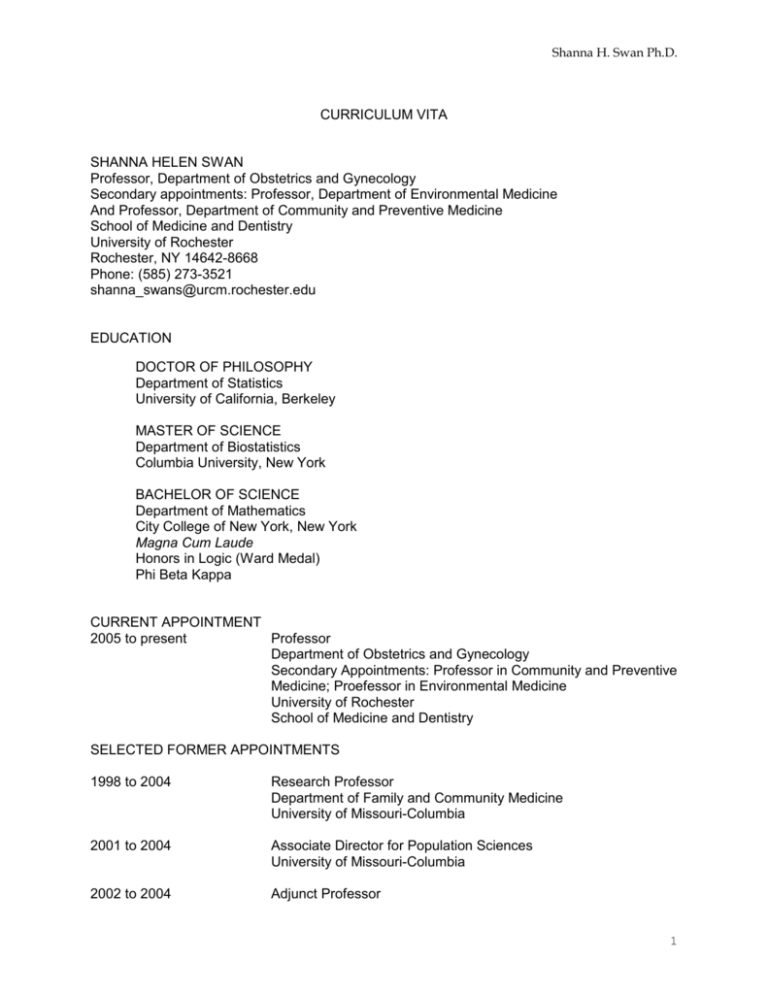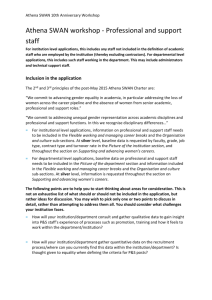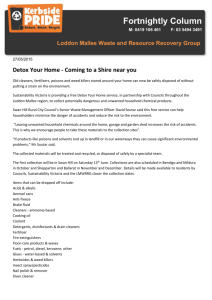Swan_CV_05 - Shanna H. Swan
advertisement

Shanna H. Swan Ph.D. CURRICULUM VITA SHANNA HELEN SWAN Professor, Department of Obstetrics and Gynecology Secondary appointments: Professor, Department of Environmental Medicine And Professor, Department of Community and Preventive Medicine School of Medicine and Dentistry University of Rochester Rochester, NY 14642-8668 Phone: (585) 273-3521 shanna_swans@urcm.rochester.edu EDUCATION DOCTOR OF PHILOSOPHY Department of Statistics University of California, Berkeley MASTER OF SCIENCE Department of Biostatistics Columbia University, New York BACHELOR OF SCIENCE Department of Mathematics City College of New York, New York Magna Cum Laude Honors in Logic (Ward Medal) Phi Beta Kappa CURRENT APPOINTMENT 2005 to present Professor Department of Obstetrics and Gynecology Secondary Appointments: Professor in Community and Preventive Medicine; Proefessor in Environmental Medicine University of Rochester School of Medicine and Dentistry SELECTED FORMER APPOINTMENTS 1998 to 2004 Research Professor Department of Family and Community Medicine University of Missouri-Columbia 2001 to 2004 Associate Director for Population Sciences University of Missouri-Columbia 2002 to 2004 Adjunct Professor 1 Shanna H. Swan Ph.D. Department of Statistics University of Missouri-Columbia 1981 to 1998 CHIEF Reproductive Epidemiology Section California Department of Health Services Berkeley, California 1980 to 1998 ADJUNCT LECTURER School of Public Health University of California, Berkeley 1990 to 1992 LECTURER New England Epidemiology Institute Tufts University Medford, MA 1979 to 1981 DIRECTOR Graduate Training Program in Biostatistics and Epidemiology School of Public Health University of California, Berkeley 1978 to 1979 VISITING ASSOCIATE PROFESSOR Department of Statistics University of California, Berkeley 1973 to 1978 ASSOCIATE PROFESSOR Department of Mathematics California State University of Sonoma Rohnert Park, California SELECTED NATIONAL AND INTERNATIONAL COMMITTEES AND STUDY SECTIONS o o o o o o World Federation of Scientists (from 2003) Environmental Concepts Made Easy Advisory Committee (from 2002) Science Communication Network Advisory Committee (from 2003) National Academy of Science: Committee on HormoneRelated Toxicants (1995-1999) National Center for Environmental Health Sciences: Environmental Health Sciences Review Committee (19911993) National Center for Health Services Research: Developmental Grants Review (1986-1988) CONSULTANCIES o o Food and Drug Administration Environmental Protection Agency 2 Shanna H. Swan Ph.D. o o Occupational Safety and Health National Institutes of Health Contraceptive Evaluation Branch Child Health and Human Development National Institute of Environmental Health Sciences PROFESSIONAL SOCIETIES o o o o o o o o Phi Beta Kappa American Public Health Association Society for Epidemiologic Research Int Soc Environmental Epidemiology American Statistical Association Biometric Society American Society of Andrology Int Soc for Exposure Assessment o o Environmental Health Perspectives Science of the Total Environment EDITORIAL ADVISORY BOARD CONFERENCE AND WORKSHOP ORGANIZER o The Precautionary Principle: Facing great risks with great uncertainties (AAAS 2000) o Gordon Research Conference on Environmental Endocrine Disruption (Vice Chair 2006, Chair 2008) o Workshop on Reproductive Toxicity of Atrazine (2005) REVIEWER FOR PROFESSIONAL JOURNALS: o American Journal of Epidemiology o American Journal of Industrial Medicine o Archives of Environmental Health o Asian Journal of Andrology o Cancer Causes and Control o Environmental Health o Environmental Health Perspectives o Environmental Research o Epidemiology o Human Reproduction o Journal of the American Medical Association o Journal of the American Public Health Association o Journal of the American Statistical Association o Paediatric and Perinatal Epidemiology 3 Shanna H. Swan Ph.D. SELECTED INVITED PRESENTATIONS SINCE 2000 Time Jan 2005 Place Copenhagen, DK Meeting/Seminar Workshop on Fertility and Reproduction Dec 2004 Zurich, CH and Lausanne, CH NRP50 Seminars Nov 2004 Oct 2004 Sep 2004 Columbia, MO MU Nutrition Seminar New Orleans, LA EPA STAR Grant Research Program: PI meeting Seminar series on Growth and Reproduction Aug 2004 Rochester, NY Seminar Series on Environmental Epidemiology Aug 2004 Baltimore, MD Departmental Seminar at Blomberg School of Public Health Measuring Impacts of Complex Environmental Exposures on Human Populations Jul 2004 Stanford, CA Women’s Health at Stanford: 21st Century Epidemiology: Measuring Environmental Impacts on Human Populations Jun 2004 New London, NH Apr 2004 Baltimore, MD Gordon Research Conference on Environmental Endocrine Disruptors Johns Hopkins Seminar Series: Addressing Health Disparities Dec 2003 Sendai, Japan Nov 2003 Rosemont, IL Oct 2003 New Orleans, LA The challenge of low-level ubiquitous exposures; A new paradigm for epidemiology? Critical challenges in assessing risks of low-level ubiquitous exposures Semen quality in relation to exposure to currently used pesticides Transforming the question of pubertal timing from temporal to geographic variation Semen quality and adult exposure to currently used pesticides Copenhagen, DK 6th International Symposium on Environmental Endocrine Disruptors Serano Conference on Puberty Timing e.hormone 2003 Title !) Semen quality of fertile US men 2) Prenatal phthalate exposure and male genital development Measuring Impacts of Complex Environmental Exposures on Human Populations Phthalates in Pregnant Women and Children Phthalate exposure in US mothers and their infants Phthalates and infant development: New findings from the Study for Future Families Measuring Impacts of Complex Environmental Exposures on Human Populations 4 Shanna H. Swan Ph.D. Sep 2003 Copenhagen, Denmark EU Symposium of Fertility and Fecundity Aug 2003 Erice, Italy World Federation of Scientists Apr 2003 Phoenix, AZ Andrology Society of America Apr 2003 Fairborn, OH Mar 2003 Indianapolis, IN Dept of Defense: Toxicology and Risk Assessment Conference University of Indiana: Endocrinology Seminar Mar 2003 Research Triangle Park, NC Nov 2002 Columbia, MO Oct 2002 Research Triangle Park, NC EPA: STAR Research Program PI Meeting Oct 2002 Tulane University, New Orleans, CA e.hormone 2002 Aug 2002 University of British Columbia, Vancouver CA University of Southern CA, Los Angeles, CA. International Society of Environmental Epidemiology Jul 2002 May 2001 South Hadley, MA Gordon Conference on Endocrine Disruption Missouri Symposium of Women’s Health Mar 2001 Okazaki, Japan Symposium on Endocrine Disruption Feb 2001 Tsukuba, Japan Oct 2000 Monterey, CA National Institute for Environmental Science: USJapan Symposium on Endocrine Disruption International Society for Exposure Assessment Aug 2002 Columbia, MO NIEHS Workshop on Human Health Effects of Phthalate Exposure Reproduction Biology SeminarFood for the 21st Century Research Seminar in Environmental Epidemiology Can historical data provide meaningful information on trends in time to pregnancy? Have environmental chemicals impaired human male reproductive performance? Separating environmental from other causes of variation in semen quality Examining the effects of EDCs on human health: An overview and a case study Can environmental pesticide exposure impair semen quality? Birth cohorts and developmental endpoints Geographic difference in semen quality of fertile US Males Study for Future Families II: Phthalates in Pregnant Women and Children Rural-urban differences in fertile US males: possible role for agricultural chemicals Health risks of water disinfection by-products Can exposure to agricultural chemicals explain the ruralurban differences in semen quality? Current use pesticides and semen quality Health and endocrine disruption: What women should know Reduced Sperm Count, Subfertility, Testicular Cancer: Steps on a Causal Pyramid? Male reproduction and EDCs: An overview Disinfection by-products and reproductive risks: Issues in exposure assessment. 5 Shanna H. Swan Ph.D. Oct 2000 Little Rock, AR Sep 2000 Jun 2000 Atlanta, GA May 2000 Copenhagen, DK Feb 2000 Washington, DC Plymouth, NH National Center for Toxicological Research: Research Seminar American College of Epidemiology Gordon Research Conference on Endocrine Disruption Hormone and endocrine disruptors in food and water: Possible effects on human health. American Association for the Advancement of Science Low dose exposures: the challenge to epidemiologists Recruitment rates; when do they matter? Limits of traditional epidemiology: The need for environmentally-sensitive epidemiology Long-term effects of intrauterine exposure to DES in humans The Precautionary Principle: Facing great risks with great uncertainties 6 Shanna H. Swan Ph.D. FUNDED RESEARCH SINCE 1998 Dates Title Agency Amount 9/1/98-8/31/04 U.S. Study of Semen Quality in Partners of Pregnant Women Increasing incidence of human male reproductive health disorders in relation to environmental effects on growth- and sex Reproductive Effects of Disinfection By-Products in Drinking Water Risk Communication and Public Participation During the Investigation of Cancer Clusters Phthalates in Pregnant Women and Children Current-use pesticides: Assessing exposure and spermatotoxicity NIEHS $2,538,880 European Commission $732,610 EPA $6,920 (Subcontract) National Science Foundation $331,019 EPA: STAR $2,816,392 EPA: STAR $672,821 7/6/00-7/1/06 2/1/00-6/1/03 4/1/02-3/31/04 9/1/02-8/31/06 11/1/05-10/31/08 7 Shanna H. Swan Ph.D. SELECTED PUBLICATIONS 1. Swan SH, Brown W. Oral contraceptive use, sexual activity and cervical carcinoma. Am J Obstet Gynecol 1981; 139(1): 52-57. 2. Swan SH. Inflammatory disease associated with oral contraceptive use. [Letter]. Lancet 1981; 2(8250):809. 3. Swan SH, Petitti DB. A review of problems and bias and confounding in epidemiologic studies of cervical neoplasia and oral contraceptive use. Am J Epidemiol 1982; 115(1): 10-18. 4. Swan SH. Establishing causation: the role of epidemiologic evidence. In: Gelfand A. ed. Proceedings of the ASA Workshop on Law and Justice Statistics. Toronto, US Govt. Printing Office, 1984. 5. Rudolph L, Swan SH. Reproductive hazards in the microelectronics industry. Occup Med 1986; 1(1): 135-143. 6. Swan SH, Robins JM. Comment on: An analysis of contaminated well water and health effects in Woburn, Massachusetts by Lagakos, Wessen and Zelen, J Am Stat Assoc 1986; 81(395): 604-609. 7. Swan SH. Smoking and cervical cancer. In: Rosenberg M, ed. Smoking and Reproductive Health, Littleton, Ma, 1987:176-185. 8. Swan SH. Diethylstilbestrol and Vaginal Clear Cell Adenocarcinoma. [Letter] Am J Med 1987; 83:372-374. 9. Swan SH. Commentary on: Uses of epidemiological information in pollution episode management by Clark Heath. In: Proceedings of the First International Conference on Environmental Epidemiology. Pittsburgh Pa, 1987. 10. Shaw G, Selvin S, Swan SH, Merrill D, Schulman J. An examination of three spatial disease clustering methodologies. Int J Epidemiol 1988; 17(4): 913-919. 11. Swan SH. Drinking water exposure and human reproductive endpoints. In: Proceedings of the Workgroup on Reproductive and Developmental Epidemiology. Cincinnati, OH, USEPA, 1988:123-144. 12. Deane M, Swan SH, Harris JA, Epstein DM, Neutra RR. Adverse pregnancy outcomes in relation to water contamination, Santa Clara County, California. Am J Epidemiol 1989; 129(5): 894-904. 13. Harnly ME, Swan SH, Holly EA, Kelter A, and Padian N. Temporal trends in the incidence of non-Hodgkin's lymphoma and selected malignancies in a population with a high incidence of acquired immunodeficiency syndrome. Am J Epidemiol 1989; 128:(2) 261-267. 8 Shanna H. Swan Ph.D. 14. Hertz-Picciotto I, Swan SH, Neutra RR, Samuels SJ. Spontaneous abortions in relation to tap water: an application of methods from survival analysis to a pregnancy follow-up study. Am J Epidemiol 1989; 130(1): 79-93. 15. Swan SH, Shaw G, Harris JA, Neutra RR. Congenital cardiac anomalies in relation to water contamination, Santa Clara County, California, 1981-1983. Am J Epidemiol 1989; 129(5): 885-893. 16. Shaw GM, Swan SH, Harris JA, Malcoe LH. Maternal water consumption during pregnancy and congenital cardiac anomalies. Epidemiology 1990; 1(3):206-211. 17. Swan SH, Shaw GM, Shulman J. Reporting accuracy among mothers of malformed and nonmalformed infants. [Letter] Am J Epidemiol 1990; 131:935-936. 18. Windham GC, Fenster L, Swan SH, Neutra RR. Use of video display terminals in pregnancy and the risk of spontaneous abortion, low birthweight, or intrauterine growth retardation. Am J Indust Med 1990; 18(6):675-688. 19. Wrensch M, Swan SH, Lipscomb J, Epstein D, Fenster L, Claxton K, Murphy PJ, Neutra RR. Pregnancy outcomes in women potentially exposed to solvent contaminated drinking water in San Jose, California. Am J Epidemiol 1990; 131(2): 283-300. 20. Wrensch M, Swan SH, Murphy PJ, Lipscomb J, Claxton K, Epstein D, Neutra RR. Hydrogeologic assessment of exposure to solvent contaminated drinking water: pregnancy outcomes in relation to exposure. Arch Environ Health 1990; 45:210-216. 21. Fenster L, Swan SH, Windham GC, Neutra RR. Assessment of reporting consistency in a case-control study of spontaneous abortions. Am J Epidemiol 1991; 133(5):477488. 22. Fenster L, Eskenazi B, Windham GC, Swan SH. Caffeine consumption during pregnancy and spontaneous abortion. Epidemiology 1991; 2(3):168-174. 23. Fenster L, Windham GC, Swan SH, Eskenazi B. Miscarriage, caffeine, and the epiphenomena of pregnancy: the causal model [Letter]. Epidemiology 1991; 2(4):313. 24. Lipscomb J, Fenster L, Wrensch M, Shusterman D, Swan SH. Pregnancy outcomes in women potentially exposed to occupational solvents and women working in the electronics industry. J Occup Med 1991; 33(5):597-604. 25. Shaw GM, Malcoe LH, Milea A, Swan SH. Chlorinated water exposures and congenital cardiac anomalies [Letter]. Epidemiology 1991; 2(6):459-460. 26. Shaw GM, Malcoe LH, Lammer EJ, Swan SH. Maternal use of cocaine during pregnancy and congenital cardiac defects. [Letter] J Pediatr 1991; 118(1):167-168. 9 Shanna H. Swan Ph.D. 27. Swan SH, Lasley B. "When is it time to get married" or "When should the assay user and the assay developer collaborate?" Environmental Health Perspectives 1991; 94:143-146. 28. Windham GC, Shusterman D, Swan SH, Fenster L, Eskanazi B. Exposure to organic solvents and adverse pregnancy outcome. Am J Indust Med 1991; 20(2):241-259. 29. Deane M, Swan SH, Harris JA, Epstein DM, Neutra RR. Adverse pregnancy outcomes in relation to water consumption: a re-analysis of data from the original Santa Clara County Study, California, 1980-1981. Epidemiology 1992; 3:94-97. 30. Fenster L, Windham GC, Swan SH, Epstein DM, Neutra RR. Tap or bottled water consumption and spontaneous abortion in a case control study of reporting and consistency. Epidemiology 1992 3(2)120-124. 31. Hertz-Picciotto I, Swan SH, Neutra RR, Samuels SJ. Reporting bias and mode of interview in a study of adverse pregnancy outcomes and water consumption. Epidemiology 1992 3(2):104-112. 32. Keen CL, Uriu-Hare JY, Swan SH, Neutra RR. The effects of water source on reproductive outcomes in Fischer-344 rats. Epidemiology 1992; 3(2):130-133. 33. Neutra RR, Swan SH, Mack T. Clusters galore: insights about environmental clusters from probability theory. Science of the Total Environment 1992; 127(1-2):187-200. 34. Neutra RR, Swan SH, Hertz-Picciotto I, Windham GC, Wrensch M, Shaw GM, Fenster L, Deane M. Potential sources of bias and confounding in environmental epidemiologic studies of pregnancy outcomes. Epidemiology 1992 3(2):134-142. 35. Shaw GM, Malcoe L, Shulman J, Cummins S, Harris J, Swan SH. Congenital cardiac anomalies relative to selected maternal exposures and conditions during early pregnancy (letter). Eur J Epidemiol 1992; 8(5): 757-760. 36. Swan SH, Neutra RR, Wrensch M, Hertz-Picciotto I, Windham G, Fenster L, Epstein D, Deane M. Is drinking water related to spontaneous abortion? Reviewing the evidence from the California Department of Health Services studies. Epidemiology 1992; 3(2):83-93. 37. Swan SH, Shaw GM, Schulman J. Reporting and selection bias in case-control studies of congenital malformations. Epidemiology 1992; 3(4):356-363. 38. Swan SH, Shaw GM, Schulman J. Reporting and selection bias in case-control studies of congenital malformations. Epidemiology 1992; 3(4):356-363. [Response to Letter] 1993; 4. 39. Thomas D, Petitti DB, Goldhaber M. Swan SH, Rappaport E, Hertz-Piccioto I. Reproductive outcomes in relation to malathion spraying in the San Francisco Bay area, 1981-1982. Epidemiology 1992 3(1); 32-39. 10 Shanna H. Swan Ph.D. 40. Windham GC, Fenster L, Swan SH. Moderate maternal and paternal alcohol consumption and the risk of spontaneous abortion. Epidemiology 1992; 3(4):364-370. 41. Windham GC, Swan SH, Fenster L, Neutra RR. Tap or bottled water consumption and spontaneous abortion: a 1986 case-control study in California. Epidemiology 1992 3(:113-119. 42. Windham GC, Swan SH, Fenster L. Parental cigarette smoking and the risk of spontaneous abortion Am J Epidemiol 1992; 135(12):1394-1403. 43. Wrensch MR, Swan SH, Lipscomb J, Epstein DM, Neutra RR, Fenster L. Spontaneous abortions and birth defects related to tap and bottled water use. Epidemiology 1992 3(2):98-103. 44. Swan SH. Pregnancy outcomes in DES daughters. In: Giusti, RM. Ed. Report of the NIH Workshop on Long-term Effects of Exposure to Diethylstilbestrol (DES). Bethesda, Md.: U.S. Department of Health and Human Services. Public Health Service. National Institutes of Health. 1992:42-9. 45. Eskenazi B, Fenster L, Swan SH, Samuels SJ. Caffeine use during pregnancy: how much is safe? [Letter; comment]. JAMA 1993; 270(1):47-48. 46. Swan SH. On toxic tort cases. [Letter] Risk Analysis 1993; 13:2. 47. Swan SH. Judging science [Letter] Science 1993; 260(5110):879. 48. Eskenazi B, Fenster L, English P, Wight S, Windham GC, Swan SH. Physical exertion as a risk factor for spontaneous abortion. Epidemiology 1994; 5(1):6-13. 49. Swan SH, Shaw GM. Should we consider a subject’s knowledge of the etiologic hypothesis in the analysis of case-control studies? [Letter] Am J Epidemiol 1994; 140:1056-1057. 50. Fenster L, Schaefer C, Mathur A, Hiatt RA, Pieper C, Von Behren J, Swan SH. Psychologic stress in the workplace and spontaneous abortion. Am J Epidemiol 1995; 142(11): 1176-1183 51. Beaumont JJ, Swan SH, Hammond K, Samuels SJ, Green RS, Hallock MF, Dominguez C, Boyd P, Schenker MB. Historical cohort investigation of spontaneous abortion in the Semiconductor Health Study: Epidemiologic methods and analyses of risk in fabrication overall and in fabrication work groups. Am J Ind Med 1995; 28(6): 735-750. 52. Schenker MB, Gold EB, Hammond SK, Beaumont J, Eskenazi B, Lasley BL, McCurdy SA, Samuels SJ, Saiki CL, Swan SH. The association of spontaneous abortion and other reproductive effects with work in the semiconductor industry. Am J Ind Med 1995; 28(6): 639-659. 53. Swan SH, Beaumont JJ, Hammond SK, VonBehren J, Green R, Hallock MF, Woskie SR, Hines CJ, Schenker MB. Historical cohort study of spontaneous abortion among 11 Shanna H. Swan Ph.D. fabrication workers in the Semiconductor Health Study: agent-level analysis. Am J Ind Med 1995; 28(6): 751-769. 54. Uriu-Hare JY, Swan SH, Bui LM, Neutra RR, Keen CL. Drinking water source and reproductive outcomes in Sprague-Dawley rats. Reprod Toxicol 1995; 9(6): 549-561. 55. Windham GC, Fenster L, Hopkins B, Swan SH. The association of moderate maternal and paternal alcohol consumption with birthweight and gestational age. Epidemiology 1995:6(6):591-597. 56. Windham GC, Swan SH, Fenster L. Maternal smoking and alcohol consumption in relation to birthweight. [Letter] Epidemiology 1995; 6:510. 57. Waller K, Reim J, Fenster L, Swan SH, Brumback B, Windham GC, Lasley B, Ettinger B, Marcus R. Bone Mass and subtle abnormalities in ovulatory function in health women. J Clin Endocrinol Metab 1996; 81(2):663-668. 58. Swan SH, Forest W. Reproductive risks of glycol ethers and other agents used in semiconductor manufacturing. Occup Hygiene 1996; 2:373-385. 59. Windham GC, Swan SH. Moderate maternal drinking and infant birthweight [letter] Epidemiology 1997 8(1):112-113. 60. Swan SH. Hormone replacement therapy and the risk of reproductive cancers. J Psychosom Obstet Gynecol 1997 18(2):165-174. 61. Fenster L, Hubbard AE, Windham GC, Waller KO, Swan SH. A prospective study of work-related physical exertion and spontaneous abortion. Epidemiology 1997; 8(1):6674. 62. Windham GC, Von Behren J, Fenster L, Schaefer C, Swan SH. Moderate maternal alcohol consumption and risk of spontaneous abortion. Epidemiology 1997; 8:509-514. 63. Fenster L, Hubbard AE, Swan SH. Windham GC, Waller K, Hiatt RA, Benowitz N. Caffeinated beverages, decaffeinated coffee and spontaneous abortion. Epidemiology 1997; 8(5):514-523. 64. Fenster L, Katz DF, Wyrobek AJ, Pieper C, Rempel DM, Oman D, Swan SH. Effects of psychological stress on human semen quality. J Androl 1997 18(2):194-202. 65. Scialli AR, Swan SH, Amler RW, Baird DD, Eskenazi B, Gist G, Hatch MC, Kesner JS, Lemasters GK, Marcus M, Paul ME, Schulte P, Taylor Z, Wilcox AJ, Zahniser. Assessment of reproductive disorders and birth defects in communities near hazardous chemical sites II. Female reproductive disorders. Reprod Toxicol 1997: 11(2-3): 231-242. 66. Swan SH, Elkin EP, Fenster L. Have sperm densities declined? A reanalysis of global trend data. Environmental Health Perspectives 1997; 105(11):1228-1232. 12 Shanna H. Swan Ph.D. 67. Swan SH, Elkin E, Fenster L. Debate about sperm count decline: reply. Environmental Health Perspectives 1998; 106(8): A370-A371 68. Swan SH, Elkin EP, Fenster L. Response: Sperm density declines. [Letter] Environmental Health Perspectives 1998; 106(9):420-421. 69. Swan SH, Waller K, Hopkins B, Windham G, Fenster L, Schaefer C, Neutra R. A prospective study of spontaneous abortion: relation to amount and source of drinking water consumed in early pregnancy. Epidemiology 1998; 9(2): 126-133. 70. Waller K, Swan SH, DeLorens G. Trihalomethanes in drinking water and spontaneous abortion. Epidemiology 1998: 9(2): 134-140. 71. Swan SH, Waller K. Drinking water and reproductive outcomes. [Letter]. Epidemiology 1998; 9(3):358. 72. Waller K, Swan SH, Windham GC, Fenter L, Elkin EP, Lasley BL. Use of urine biomarkers to evaluate menstrual function in healthy premenopausal women. Amer J Epidemiol 1998; 147(11):1071-1080. 73. Swan SH, Waller K. Disinfection by-products and adverse pregnancy outcomes: what is the agent and how should it be measured? (Editorial). Epidemiology 1998; 9(5):479481. 74. Swan SH. Sperm count decline inconclusive. Health & Environment Digest 1998; 12:68-70. 75. Swan SH. Selection biases in semen study? Fertil Steril 1998 69(6): 1158. 76. Fowler B, LaDou J, Osoria AM, Paul M, Swan SH, Teitlebaum DT. Open letter to the Greenock telegraph, Greenock, Scotland. Int J Occup Med Environ Health 1998; 4(3): 204-205. 77. Fenster L, Waller K, Chen J, Hubbard AE, Windham GC, Elkin E, Swan S. Psychological stress in the workplace and menstrual function. Am J Epidemiol 1999; 149(2):127-134. 78. Windham GC, Elkin EP, Swan SH, Waller KO, Fenster L. Cigarette smoking and effects on menstrual function. Obstet Gynecol 1999; 93(1):59-65. 79. Kharrazi M, Epstein D, Hopkins B, Kreutzer R, Doeberrt G, HIatt R, Swan SH, Eskenazi B, Pirkle JL, Bernert JT. Evaluation of four maternal smoking questions. Pub Health Reports 1999; 114(1):60-70. 80. Fenster L, Quale C, Waller K, Windham G, Elkin E, Benowitz N, Swan SH. Caffeine consumption and menstrual function. Am J Epidemiol 1999; 149(6): 550-557. 81. Hovi SL, Hemminki E, Swan SH. Cosmetic and postmastectomy breast implants: Finnish women’s experiences. J Womens Health & Gender-Based Med 1999; 8(7): 933-939. 13 Shanna H. Swan Ph.D. 82. Elkin EP, Windham GC, Benowitz NL, Swan SH. Occasional smoking in a study of premenopausal women. Amer J Public Health 1999; 89(3):420-421. 83. Cunha, JR, Forsberg J-G, Golden R., Haney A, Iguchi T, Newbold R, Swan S, Welshons W. New Approaches for Estimating Risk from Exposure to Diethylstilbestrol. Env Health Perspect 1999; 107, Supplement 4: 625-30. 84. Swan SH, Hertz-Picciotto I. Reasons for infecundity [Letter]. Family Planning Perspect 1999; 31(3):156-157. 85. Swan SH, Elkin EP. Declining semen quality: can the past inform the present? BioEssays: News and Reviews in Molecular, Cellular and Developmental Biology 1999; 21(7):614-621. 86. Andersen AG, Jorgensen N, Andersson AM, Carlsen E, Skakkebaek NE, Jensen TK, Keiding N, Swan SH. Serum levels of testosterone do not provide evidence of selection bias in studies of male reproductive health. Epidemiology 2000; 11(2):232234. 87. Windham GC, Shaw GM, Todoroff K, Swan SH. Miscarriage and the use of multivitamins or folic acid [Letter]. Am J Med Genetics AJMG 2000, 90(3):261-262. 88. Windham GC, Hopkins B, Fenster L, Swan SH. Prenatal Active or Passive Tobacco Smoke Exposure and the Risk of Preterm Delivery or LBW. Epidemiology 2000; 11(4):427-433. 89. Swan SH, Elkin EP, Fenster L. The question of declining sperm density revisited: an analysis of 101 studies published 1934-1996. Environmental Health Perspectives 2000; 108(10):961-966. 90. Swan SH. Long term human effects of prenatal exposure to diethylstilbestrol. APMIS 2000;108: 793-804. 91. Windham, GC, Mitchell PR, Fenster L, Lasley BL, Waller K, Swan, SH. Tobacco smoke exposure and urinary hormone excretion. American Journal of Epidemiology 2001; 153:S136. 92. Swan, SH. Intrauterine exposure to diethylstilbestrol: long-term effects in humans. In Hormones and Endocrine Disruptors in Food and Water: Possible Impact on Human Health. (ed. By A.M. Andersson, KN Grigor, E. Rajpert de Meyts, H. Leffers, NE Skakkebaek). Munksgaard Copenhagen 2001. 93. Ibarreta D, Swan SH. The DES story: long-term consequences of prenatal exposure. In: Harremoes P, Gee D, MacGarvin M, Stirling A, Keys J, Wynne B, et al., editors. Late lessons from early warnings: the precautionary principle 1896-2000. Environment Issue Report, No. 22. Copenhagen: European Environment Agency; 2001. p. 84-92. 94. Waller K, Swan SH, Windham G, Fenster L. Influence of exposure assessment methods on risk estimates in an epidemiologic study of total trihalomethane exposure 14 Shanna H. Swan Ph.D. and spontaneous abortion. J Exposure Assess Environ Epidemiol 2001; 11(6):522531. 95. Goldman LR, Newbold R, Swan SH. Exposure to soy-based formula in infancy. [Letter]. JAMA 2001; 286(19):2402-2403. 96. Swan SH and Vom Saal FS. Alterations in male reproductive development: the role of endocrine disrupting chemicals. In: The Handbook of Environmental Chemistry Vol. 3M: endocrine disruptors (ed. by M. Metzler) Springer-Verlag Berlin Heidelberg 2002, 131-170. 97. Windham GC, Elkin E, Fenster L, Waller K, Anderson M, Mitchell PR, Lasley B, Swan SH. Ovarian hormones in premenopausal women: variation by demographic, reproductive and menstrual cycle characteristics. Epidemiology 2002; 13(6):675-684. 98. Swan SH. Brazil C, Drobnis EZ, Liu, F, Kruse RL, Hatch M, Redmon, JB, Wang C, Overstreet JW, and the Study for Future Families Research Group. Geographic differences in semen quality of fertile US males. Environmental Health Perspectives 2003; 111(4): 414-420. 99. Swan SH. Environmental agents: Causes of variation in semen quality? (Invited Commentary) Epidemiology 2003; 14:261-262. 100. Windham G. Waller K, Anderson M, Fenster L, Mendola P, Swan SH. Chlorination byproducts in drinking water and menstrual cycle function. Environmental Health Perspectives 2003; 111(7):935-941. 101. Swan SH, Kruse R, Liu F, Barr D, Drobnis E, Redmon B, Wang C, Brazil C, Overstreet JW, and the Study for Future Families Research Group. Biomarkers of pesticide exposure in relation to and semen quality. Environmental Health Perspectives 2003; 111:1478-1484. 102. Fenster L, Waller K, Windham G, Henneman T, Anderson M, Mendola P, Overstreet JW, Swan SH. Trihalomethane levels in home tap water and semen quality. Epidemiology 2003; 14(6):650-658. 103. Swan SH. Semen quality in relation to pesticide exposure in Missouri males. [Letter] Missouri Medicine 2003; 100(6): 554. 104. Myers JP, Guillette LJ, Jr., Palanza P, Parmigiani S, Swan SH, Vom Saal FS. Endocrine disrupting chemicals. In: Ragaini RC, editor. International Seminar on Nuclear War and Planetary Emergencies, 30th session: "E. Majorana" Centre for Scientific Culture, Erice, Italy, 18-26 August 2003. River Edge, N.J.: World Scientific; 2004, 105-121. 105. Brazil C, Swan SH, Drobnis EZ, Liu F, Wang C, Redmon JB, Overstreet JW and the Study for Future Families Research Group. Standardized Methods for Semen Evaluation in a Multicenter Research Study. J Androlog 2004; 25:635-644. 15 Shanna H. Swan Ph.D. 106. Brazil C, Swan SH, Tollner CR, Treece C, Drobnis EZ, Wang C, Redmon JB, Overstreet JW and the Study for Future Families Research Group. Quality Control of Laboratory Methods for Semen Evaluation in a Multicenter Research Study. J Androlog 2004; 25: 645-656. 107. Ren C, Sun D, Speckman PL, Chong ZH. Swan SH. Hierarchical Models for the Probabilities of Conception. In press, Biometrical Journa 2004. 108. Swan SH. Your environment; your fertility: is there a link? In: INCIID A.R.T. Directory 2005. Arlington, VA: InterNational Council on Infertility Information Dissemination (INCIID); 2004. p. 13-19. 109. Slama R, Bouyer J, Windham G, Fenster L, Werwatz A, Swan SH. Influence of Paternal Age on the risk of spontaneous abortion. In press, Amer J Epidemiol. 2005 110. Carlsen E, Swan SH, Petersen JH, Skakkebæk, Longitudinal changes in semen parameters in young Danish men from the Copenhagen area. In press, Human Reprod. 2005. 111. Swan SH, Main KM, Liu, F, Stewart SL, Kruse RL, Calafat AM, Mao CS, Redmon JB, Ternand CL, Sullivan S, Teague JL. Anogenital distance -a marker of fetal androgen action- is decreased in male infants following phthalate exposure during pregnancy. Submitted to Env Health Perspect. DOCUMENTS AND REPORTS CO-AUTHORED 112. State of California, Health and Welfare Agency; Department of Health Services, Guidelines for Chemical Carcinogen Risk Assessment and their Scientific Rational. 1985. 113. State of California, Health and Welfare Agency, Department of Health Services, Pregnancy Outcomes in Santa Clara County 1980-1982: Reports of Two Epidemiological Studies. 1985. 114. State of California, Health and Welfare Agency, Department of Health Services, Pregnancy Outcomes in Santa Clara County 1980-1985. 1988. 115. State of California, Health and Welfare Agency, Department of Health Services, Water Exposure and Pregnancy Outcomes. 1988. 116. University of California, Davis, Epidemiologic Study of Reproductive and other Health Effects among Workers Employed in the Manufacture of Seminconductors, 1992. 117. Scialli AR, Swan SH, Baird DD et al. Female Reproductive Disorders, in Standardized Assessment of Birth Defects and Reproductive Disorders in Environmental Health Field Studies. Ed. GL Terracciano, GK Lemasters RW Amler. US Department of Health and Human Services. National Technical Information Service, Virginia. Publication PB96-199609, 1996. 16 Shanna H. Swan Ph.D. 118. National Research Council. Committee Report on Hormonally Active Agents in the Environment. National Academy Press, Washington DC 1999. December 14, 2004 17






